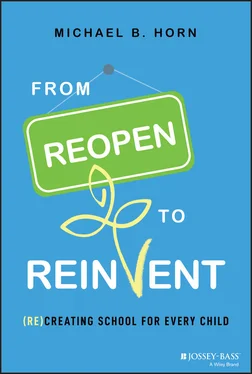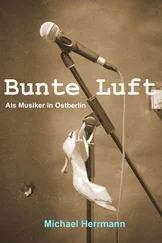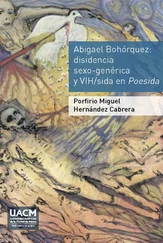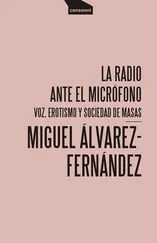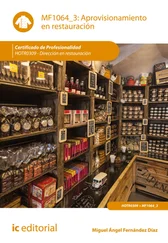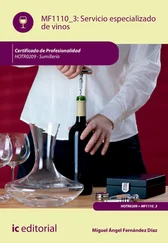Michael B. Horn - From Reopen to Reinvent
Здесь есть возможность читать онлайн «Michael B. Horn - From Reopen to Reinvent» — ознакомительный отрывок электронной книги совершенно бесплатно, а после прочтения отрывка купить полную версию. В некоторых случаях можно слушать аудио, скачать через торрент в формате fb2 и присутствует краткое содержание. Жанр: unrecognised, на английском языке. Описание произведения, (предисловие) а так же отзывы посетителей доступны на портале библиотеки ЛибКат.
- Название:From Reopen to Reinvent
- Автор:
- Жанр:
- Год:неизвестен
- ISBN:нет данных
- Рейтинг книги:4 / 5. Голосов: 1
-
Избранное:Добавить в избранное
- Отзывы:
-
Ваша оценка:
- 80
- 1
- 2
- 3
- 4
- 5
From Reopen to Reinvent: краткое содержание, описание и аннотация
Предлагаем к чтению аннотацию, описание, краткое содержание или предисловие (зависит от того, что написал сам автор книги «From Reopen to Reinvent»). Если вы не нашли необходимую информацию о книге — напишите в комментариях, мы постараемся отыскать её.
From Reopen to Reinvent,
From Reopen to Reinvent
From Reopen to Reinvent
From Reopen to Reinvent — читать онлайн ознакомительный отрывок
Ниже представлен текст книги, разбитый по страницам. Система сохранения места последней прочитанной страницы, позволяет с удобством читать онлайн бесплатно книгу «From Reopen to Reinvent», без необходимости каждый раз заново искать на чём Вы остановились. Поставьте закладку, и сможете в любой момент перейти на страницу, на которой закончили чтение.
Интервал:
Закладка:
The charge might be to design a more compelling experience that focuses less on the time students are taught and more on helping each child develop character and habits of success, like agency and executive function skills; ensuring each child has a strong social, emotional, and health foundation with a reservoir of social capital; and rather than simply focusing on the teaching of academic knowledge and skills, making sure each child learns and masters those that are critical and allows them to build passions and develop their unique potential. The traditional hierarchy in a district could continue to focus on operating schools as we've known them, while this group focuses on implementing different innovations designed to give teachers and students more support.
This model suggests a new way for districts to engage with microschools and learning pods. Many districts have viewed these emergent schools as threats to the way they have always operated or things that will create inequity. But the threat–opportunity perspective helps us see that districts could reframe microschools and learning pods as something they themselves could operate to make sure that all children have deep and healthy social relationships. They could envision them as part of a mosaic of offerings so that they are able to provide an array of options that fit the different circumstances of all students and families. And they could see them as ways to offer personalized learning experiences for children's particular needs so that children don't fall behind in learning to read or doing math or in the exploration of coherent bodies of knowledge.
The key is to escape threat rigidity by arming a relatively independent team of educators absolved from their existing responsibilities. However it's done, the autonomy and focus is critical.
As Jeff Wetzler, cofounder of Transcend Education, a school design consultancy, said, “[The work is] time consuming. We have yet to find a way for this to work without some protected time and space. If you just try to jam it into the existing schedule, it just doesn't happen.”
Or as Tavenner said, “School doesn't stop. Usually educators think ‘I get one week to do my master visioning’ in the summer and that's it.” 14 That's not enough time to rethink the possibilities for an already-antiquated schooling model and view it as a true greenfield opportunity.
We dig deeper throughout the book on how to rethink schooling, but there's one final observation in Gilbert's findings worth highlighting.
In his research, an outside party wielded significant influence with each of the newspapers that moved successfully from seeing the Internet as a threat to viewing it as an opportunity and tasking an independent group to chase it. A board member, associate, or someone new to the organization would say that the newspaper must question its fundamental assumptions around what their online site and the supporting structure should look like rather than simply replicating what they already had—just online. As Gilbert wrote, “Involving outside influence when deciding how to respond to discontinuous change will increase the likelihood that managers will structurally differentiate a new venture from its parent organization.” 15
In schools, that implies that school boards and the broader community have a critical role to play in giving permission to or pushing school and district leadership to create relatively independent entities that pioneer new ways of schooling—whether those arrangements are new schools, schools within schools, microschools, or learning pods. As Gilbert wrote, “Outside influence, structural differentiation, and opportunity framing [that] combine to relax routine rigidity in a new venture” were consistently critical in times of discontinuous change. 16 Examples from real districts help show what that arrangement and sequencing can look like.
Mastery School of Hawken:
https://www.youtube.com/watch?v=LZ2Pk6TcQCU
Kettle Moraine
About 30 minutes outside Milwaukee sits the Kettle Moraine School District. A suburban school district with 11 schools that serve just under 4,000 students who hail mostly from middle- and upper-income families, the district was considered relatively high-performing, with over 80 percent of graduates enrolling in postsecondary education and training each year.
Beneath the positive results, however, there were opportunities to improve. Only 45 percent of students were completing their postsecondary programs—below the national average. With a threat identified, the district marshaled resources to address the challenge.
The district didn't maintain the threat framing. Once it had galvanized resources, it moved to create a variety of independent environments in which to personalize learning through microschools—schools within schools in this case—of no more than 180 students. Each had its own unique spin. Kettle Moraine authorized three charter schools on its high school campus and one at one of its elementary schools to help implement a mastery-based model that personalizes learning, along with seven “houses” in its middle school.
Within each learning environment, educators implemented comprehensive, data-rich learner profiles and customized learning paths for each student in which students' progress is contingent upon their performance. Its elementary micro charter school, for example, centers around projects. Students use the projects to demonstrate mastery of the required competencies. Another microschool at the high school level allows students to earn nursing and emergency medical technician certifications.
With a high degree of accountability in place, the innovations appear to be working. 17 Results on the PISA exam, the OECD's Test for Schools, would rank the district among the top countries in the world. According to Education Week , the students in the district's traditional high school performed as well as students in Canada, Finland, and other European countries, while its students in its charter school performed in the same ballpark as that of Singapore—the second-highest-ranking country at the time—with very high engagement in the learning. 18
Kettle Moraine School District:
https://www.youtube.com/watch?v=GhuTgnAz6fQ
Microschool Movement
Many school districts looked upon the rapid growth of microschools and learning pods during the pandemic as something akin to students signing up for the Russian School of Mathematics outside of school hours. They thought it was something certain families were doing to give their children a leg up on the other students around them. They wished these new schools would disappear.
But some districts took a different perspective.
As Eric Gordon, the CEO of the Cleveland Municipal School District, said, “Suburban communities were forming pods on their own. Why shouldn't my kids have those benefits?” 19
The district leveraged new resources by working with a variety of community organizations—the Cleveland Foundation, MyCom, Say Yes Cleveland, and United Way of Cleveland—to open 24 pods during the pandemic and serve 808 of Cleveland's most vulnerable students. 20
Cleveland was among the 11 percent of school districts, according to a national survey by the Clayton Christensen Institute, that operated “learning hubs” in the Spring of 2021. According to the survey, 5 percent of districts intend to continue operating pods postpandemic. 21
The Center for Reinventing Public Education worked with TNTP, a nonprofit education consultancy, to create more in-depth partnerships with six school districts that would lead to something more lasting and transformational out of the pod movement. 22
The DeKalb County School District in Georgia, for example, is using pods to reinvent alternative schools, which serve students who have dropped out or transferred from traditional schools. Given that many alternative schools have traditionally struggled, it's a place where the district thinks pods can help make a difference.
Читать дальшеИнтервал:
Закладка:
Похожие книги на «From Reopen to Reinvent»
Представляем Вашему вниманию похожие книги на «From Reopen to Reinvent» списком для выбора. Мы отобрали схожую по названию и смыслу литературу в надежде предоставить читателям больше вариантов отыскать новые, интересные, ещё непрочитанные произведения.
Обсуждение, отзывы о книге «From Reopen to Reinvent» и просто собственные мнения читателей. Оставьте ваши комментарии, напишите, что Вы думаете о произведении, его смысле или главных героях. Укажите что конкретно понравилось, а что нет, и почему Вы так считаете.
